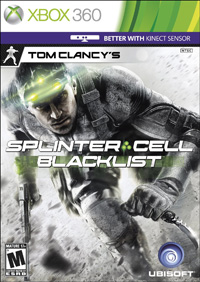 Splinter Cell: Blacklist
Splinter Cell: Blacklist
(Ubisoft for Xbox 360)
By Mike Delano
With the next generation of consoles coming later this year, it’s a natural time to take stock of the current gen’s impressive library of games and ponder which ones will take on classic status and which ones will simply disappear from memory as time marches on toward the next big thing. As I scan my shelf to see which 360/PS3 titles will be keepers, one element defines many of the games in the “keep” pile: Movement. As in, is it actually fun to move your character around the world and to control his or her movements for hours on end? Is it something I’d want to revisit after that new car smell is gone? With so many games of the past decade focused on narrative — and don’t get me wrong, there have been some great stories told — the actual act of “playing the game” sometimes takes a back seat in terms of importance.
But the best-playing games stand out, and they’re always worth coming back to. Bayonetta, of course. Gears of War. Guitar Hero/Rock Band. And Splinter Cell: Blacklist now sneaks onto that list as well. It builds on the fluid yet precise movement of 2010’s excellent Splinter Cell: Conviction, but gives you even more tools to consider and enjoy as you guide Sam Fisher across varied environments that accommodate all sorts of play styles.
And “even more” is definitely the name of the game here: Blacklist is stuffed with great content, acting as a celebration of the series and a fitting final display of power for this round of consoles. Since Sam is now the head of the Fourth Echelon counter-terrorism group, he and his team travel the world in their mobile headquarters, which is where you spend your time between missions. Simply talking to the people on board or checking your world map eliminates the need for a boring main menu, because everything is integrated: The story, co-op missions (most of which can be played solo), online multiplayer, and even fun meta-game missions. Since your experience carries over across all of these modes, you get the feeling that you really are a badass, jack-of-all-trades world cop, and it’s also a smart design choice for communicating the game’s tremendous breadth.
That’s the worldview, but once your boots are on the ground, the options are just as vast. Each of the large, layered missions can be approached several different ways; the game categorizes three such styles as Ghost (remaining completely unseen), Panther (killing silently), and Assault (guns blazing), and rates your performance in each category at the end of a mission. So you have at least three different ways to play each scenario, and that’s after your initial run-through, which will probably be a mix of all three. And, of course, the wide array of weapons and gadgets ensures that even those who stick to one of the Ghost, Panther, or Assault paths will still find plenty of customization and combinations inside those individual branches.
Even without a single high-tech gadget or heavy firepower, the joy of playing as Sam is fully realized in Blacklist. Slinking around the map, watching the patterns of the guards, identifying your shadowy escape route, chaining together a room-clearing Mark and Execute attack after pouncing down from the ceiling — that’s the type of gorgeous movement that is supremely satisfying to orchestrate, and it’s the kind of evergreen experience that earns it a permanent spot in the “keep” pile.
(www.ubisoft.com)



